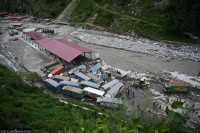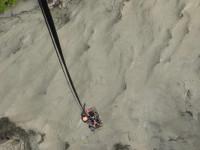National
Tigers sighted high in the hills. Wildlife experts wonder why they are moving north
Improved green cover, less disturbance in upper regions compared to the Tarai districts where they are facing habitat loss and decline in prey could be prompting tigers to move up.
Chandan Kumar Mandal
A few years ago, there were anecdotal reports of sightings of a royal Bengal tiger in Dadeldhura, a hill district in the far west. Then in mid-2018, a tiger was spotted on camera in Beldangi of Jogbudha area of the district.
A year before that sighting, wildlife conservationists had managed to capture footage of a big cat prowling a community forest in Dadeldhura.
Then in April this year, a tiger was once again captured on camera trap at an altitude of 2,500 metres in a Dadeldhura forest—the highest ever recorded sighting of the big cat in the country of 235 tigers.
Now another tiger has been photographed on camera. This time at the other end of the country—in Ilam. This latest spotting of the tiger at an elevation of 3,165 metres beat the previous record of a tiger sighting.
Government agencies confirmed that never before had a tiger been spotted and captured on camera at such an altitude in the country’s documented history.
The sighting in Ilam has left wildlife experts baffled once again.
“It has come as a surprise that a tiger was spotted in Ilam,” Haribhadra Acharya, a spokesperson for the Department of National Park and Wildlife Conservation, told the Post. “Our history shows that big cats had gone extinct in areas east of the Bagmati river.”
The Bagmati river marks the eastern border of Rautahat district with Sarlahi.
Despite the sightings in Dadeldhura and Ilam, conventional wisdom has it that tigers live in the country’s protected areas in southern plains—Parsa National Park, Chitwan National Park, Banke National Park, Bardia National Park and Shuklaphanta National Park—as well forests adjoining them.
The latest tiger census, in 2018, detected signs of tiger presence in 12 districts—Bara, Parsa, Makwanpur, Chitwan, Nawalparasi, Dang, Salyan, Banke, Bardiya, Surkhet, Kailali and Kanchanpur—of the 18 districts surveyed across all potential tiger habitats in the Terai Arc Landscape.
“How amazing [it is] to detect tigers returning to the upper edge of their range,” Eric Dinerstein, who has worked in tiger conservation in Nepal since the 1970s, was quoted as saying in Red Panda Network’s press release.
Dinerstein, the author of ‘Tigerland and Other Unintended Destinations’, described the sighting as “yet another accomplishment for Nepal, leading the world in wildlife restoration.”
Nepal has showcased a remarkable achievement in conserving its tiger population.
Along with 12 other countries, Nepal had pledged to double the population of tigers between 2009 and 2022, the “TX2” target of the 2010 Saint Petersburg Declaration on Tiger Conservation.
While the country’s tiger population was 121 in 2009, the 2018 tiger census put the number of big cats in the country at 235, a landmark achievement in being ahead of the pack.
Baburam Lamichhane, who has conducted extensive research on tigers, finds the spotting of the tiger in Ilam surprising for its location.
“Altitude and climate-wise, this is not surprising for me as tigers have lived in higher altitudes. What surprised me was that it was seen in Ilam as we have no evidence of tigers east of Bagmati in recent years,” said Lamichhane.
Tigers have been spotted at even higher altitudes in India and Bhutan.
In India, the Royal Bengal Tiger has been sighted at an altitude of 3,630 metres and in Bhutan at above 4,000 metres.
“Even when we study the possibility of tigers in the eastern part, focus has been on districts like Sarlahi, Mahottari, Sindhuli, Saptari and Udayapur,” said Lamichhane, who is the chief of the Biodiversity Conservation Centre, Sauraha, under the National Trust for Nature Conservation. “Although there had been anecdotal reports of sightings of tigers in Udayapur in the early 1990s, capturing of a tiger on camera in Ilam is unexpected.”
However, wildlife experts do not entirely discard the possibility of tigers roaming hill areas as in Dadeldhura and Ilam.
“There were always anecdotal references to tigers dwelling in hilly regions,” said Acharya, the spokesman, who is also the ecologist with the Department of National Park and Wildlife Conservation. “Now we are getting reports of tigers being spotted in hills—from the far east in Ilam to the far west in Dadeldhura.”
The latest photographs of the tiger in Ilam were captured by one of 20 camera traps set up to monitor the movements of ten red pandas equipped with GPS-satellite collars in Kanchenjunga Conservation Area in eastern Nepal by Red Panda Network, a conservation organisation.
“Historically, tigers lived in the mid-hills as well. It is believed that tigers roamed in the hill areas 500-600 years ago before their population remained confined to low-lying areas,” said Hem Sagar Baral, a wildlife expert and Nepal head for the Zoological Society of London. “Once they could not survive in the hills, where there were no more dense forests, they must have come down south and remained there.”
According to Baral, tigers might have started climbing up mountains with the rise in their population, improved conservation efforts and improvement in green cover in the country.
“As there is an increase in their population, tigers will definitely go somewhere,” said Baral. “Although there may not be adequate prey density in community forests, these forest areas work as corridors and make it easier for tigers to travel further.”
With the increase in tiger population, habitat loss and decline in prey base in their natural habitat, tigers are found to be straying into human settlements. Depredation of cattle and killing of locals have been observed in areas adjoining protected areas. However, tigers coming out of the jungle had largely remained limited to the Tarai only.
Conservationists are not sure where this tiger in Ilam came from and whether there could be more tigers in the area.
“This particular tiger might have crossed over into Nepal as there are tiger habitats in the Indian state of Assam and also in Bhutan,” said Acharya. “We cannot say about the origin of this tiger as of now, but there are records of tigers travelling hundreds of kilometers.”
The Kanchenjunga Conservation Area, where the tiger was photographed twice in November, is bordered by the Tibet Autonomous Region of China to the north and Sikkim, India to the east.
It adjoins Khangchendzonga National Park in Sikkim where the presence of tigers was reported only last year. Although there has been no photographic evidence of tigers in Sikkim since the 1980s, there were anecdotal reports of tiger sighting.
Baral asserts the tiger was not from Koshi Tappu Wildlife Reserve, the protected area in eastern Nepal. Nor had it travelled from Parsa National Park, the eastern most national park of the country with the tiger population, according to him.
“It seems the tiger has come from India. The tiger must be a young one and of exploratory nature,” said Baral. “Undoubtedly, the main habitat of tigers is plains and inner Madhes in Nepal. But they can travel up to hills in a radius if we keep inner Madhes as its central habitat.”
Lamichhane, too, said it is less likely that a tiger from Parsa National Park had travelled to Ilam.
“But it is not impossible either. It’s not that there is no corridor connectivity from Parsa to Ilam as tigers can walk through unusual areas like human settlement and agricultural lands during the night without anyone noticing,” said Lamichhane. “Tigers can travel for hundreds of kilometres and their presence cannot be detected because common people cannot study their pugmarks. But this particular tiger must have come from the Indian side, as tiger presence has been found in the low-lying areas of West Bengal too.”
Presence of thriving wildlife in the Panchthar-Ilam-Taplejung corridor, where the tiger was photographed, has already been established with camera traps deployed by the Red Panda Network in the past as well.
“Lack of evidence-based studies in the past may have deprived us from such unusual sightings,” Damber Bista from the University of Queensland, who is leading the GPS-collar red panda study in Ilam district, was quoted in Network’s statement. “Camera-trapping in other potential sites at mid- and high-mountain ranges may reveal more.”
With the latest sighting of a tiger, conservationists say the corridor needs to be conserved for it to be functional for wildlife.
This tiger sighting in Ilam district brings the total number of cat species in the Kangchenjunga Landscape in eastern Nepal to eight, including leopard, clouded leopard, snow leopard, Asiatic golden cat, leopard cat, jungle cat, and marbled cat.
“Ilam and Panchthar areas have dense forests which may also provide enough prey besides cattle in human settlements. The latest sighting shows tigers are moving up from where they had descended after massive deforestation and increase in human settlements,” said Acharya. “Now disturbances from human activities and the growing population is in the southern plains but increase in green cover in the hills, seem to have encouraged them to travel north.”
Lamichhane also agrees that deforestation, hunting and loss of prey base in the past in the hills, forced tigers to come down.
Wildlife experts have also been connecting the impact of climate change on tiger behaviour and their dispersal.
“Climate change, mainly drying up of water resources, might force tigers to leave their original habitat and migrate elsewhere,” said Baral, whose organisation along with National Trust for Nature Conservation has started studying the effects of climate change on the tiger population in the country. “It has been observed that tigers have started moving up in search of water, walking along the river that originates in hills.”
Government agencies have realised the need to study why tigers are walking up to the hills and if there could be more tigers there.
“The latest incident recommends a detailed study on why tigers are frequently sighted in hill areas,” said Acharya, the ecologist. “A study is also required to ascertain whether areas like Ilam and Dadheldhura have more tigers.”




 22.12°C Kathmandu
22.12°C Kathmandu















